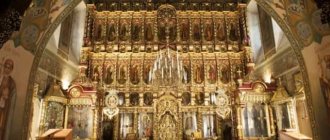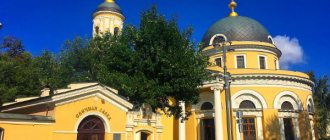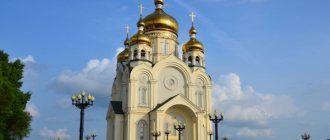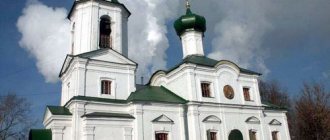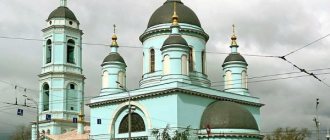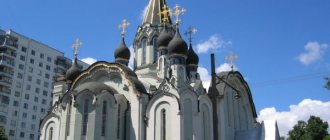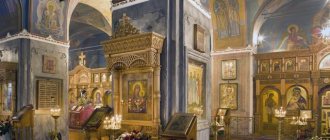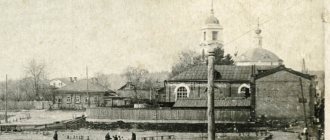Mir
Russia Oryol Region Oryol Temple of the Smolensk Icon of the Mother of God (Oryol) Map is loading…
{"format":"leaflet","minzoom":false,"maxzoom":false,"limit":50,"offset":0,"link":"all","sort":[""], "order":[],"headers":"show","mainlabel":"","intro":"","outro":"","searchlabel":"\u2026 \u0441\u043b\u0435\ u0434\u0443\u044e\u0449\u0438\u0435 \u0440\u0435\u0437\u0443\u043b\u044c\u0442\u0430\u0442\u044b","default":"","import-annotation":false,"width ":"auto","height":"350px","centre":{"text":"","title":"""link":"""lat":52.9536209999999982755980454385280609130859375,"lon": 36.06832899999999852980181458406150341033935546875,"icon":""},"title":"","label":"","icon":"","lines":[],"polygons":[],"circles":[ ],"rectangles":[],"copycoords":false,"static":false,"zoom":8,"defzoom":14,"layers":["OpenStreetMap"],"image layers":[] ,"overlays":[],"resizable":false,"fullscreen":true,"scrollwheelzoom":true,"cluster":false,"clustermaxzoom":9,"clusterzoomonclick":true,"clustermaxradius":80, "clusterspiderfy":true,"geojson":"","clicktarget":"","showtitle":true,"hidenamespace":false,"template":"","userparam":"","activeicon": "","pagelabel":false,"ajaxcoordproperty":"","ajaxquery":"","locations":[{"text":"\u003Cb\u003E\u003Ca href=\"/palomnik/%D0% A5%D1%80%D0%B0%D0%BC_%D0%A1%D0%BC%D0%BE%D0%BB%D0%B5%D0%BD%D1%81%D0%BA%D0%BE% D0%B9_%D0%B8%D0%BA%D0%BE%D0%BD%D1%8B_%D0%91%D0%BE%D0%B6%D0%B8%D0%B5%D0%B9_%D0% 9C%D0%B0%D1%82%D0%B5%D1%80%D0%B8_(%D0%9E%D1%80%D1%91%D0%BB)\» title=\»\u0425\u0440\ u0430\u043c \u0421\u043c\u043e\u043b\u0435\u043d\u0441\u043a\u043e\u0439 \u0438\u043a\u043e\u043d\u044b \u0411\u043e\u0436\u 0438\u0435\u0439\u041c\u0430\ u0442\u0435\u0440\u0438 (\u041e\u0440\u0451\u043b)\»\u003E\u0425\u0440\u0430\u043c \u0421\u043c\u043e\u043b\u0435\u043d\u0441 \u043a\u043e\u0439\u043a\u043e\u0439\ u0438\u043a\u043e\u043d\u044b \u0411\u043e\u0436\u0438\u0435\u0439 \u041c\u0430\u0442\u0435\u0440\u0438 (\u041e\u0440\u0451\u 043b)\u003C/a\u003E\ u003C/b\u003E\u003Chr /\u003E\u003Ca href=\"/palomnik/%D0%A1%D0%B2%D0%BE%D0%B9%D1%81%D1%82%D0%B2%D0% BE:%D0%90%D0%BD%D0%BD%D0%BE%D1%82%D0%B0%D1%86%D0%B8%D1%8F\» title=\»\u0421\u0432\u043e \u0439\u0441\u0442\u0432\u043e:\u0410\u043d\u043d\u043e\u0442\u0430\u0446\u0438\u044f\»\u003E\u0410\u043d\u043d\u043e\u0442 \u0430\u0446\u0438\ u044f\u003C/a\u003E: »'\u0425\u0440\u0430\u043c \u0421\u043c\u043e\u043b\u0435\u043d\u0441\u043a\u043e\u0439 \u0438\u043a\u0 43e\u043d\u044b\u0411 '' - '' 044b\u0439\u043a\u0440\ u0443\u043f\u043d\u044b\u0439 \u0445\u0440\u0430\u043c \u0433\u043e\u0440\u043e\u0434\u0430, \u0432\u044b\u043f\u043e\u043b\ u043d\u0435\u043d\u0432\u0440 \u0443\u0441\u0441\u043a\u043e-\u0432\u0438\u0437\u0430\u043d\u0442\u0438\u0439\u0441\u043a\u043e\u043c \u0441\u0442\u0438\ u043b\u0435. \u0411\u044b\u043b \u0437\u0430\u043a\u0440\u044b\u0442 \u0432 1938 \u0433\u043e\u0434\u0443. 1994 1994 1994 \u0440\u043b\u043e\u0432\u0441\ u043a\u043e-\u041b\u0438\u0432\u0435\u043d\u0441\u043a\u043e\u0439 \u0435\u043f\u0430\u0440\u0445\u0438\u0438, \u0438 \u043a 1995\u0433\u043e\u0434\u0443 \u0431\u044b\u043b\u0438 \u043d\u0430\u0447\u0430\u0442\u044b \u0432\u043e\u0441\u0441\u0442\u0430\u043d\u043e\u0432\u0438\ u0442\u0435\u043b\u044c\u043d ""title":"\u0425\u0440\u0430\u043c \u043a\u043e \u0439 \u0438\u043a\u043e\u043d\u044b \u0411\u043e\u0436\u0438\u0435\u0439 \u041c\u0430\u0442\u0435\u0440\u0438 (\u041e\u044 0\u0451\u043b)","link ":"","lat":52.9536209999999982755980454385280609130859375,"lon":36.06832899999999852980181458406150341033935546875,"icon":""}],"imageLa yers":[]}
52.953621; 36.068329
Russia, Orel, Normandy-Neman street, 27
Orel, Oryol region 302026
Russia
Telephone:
+7 (4862) 590431
Email:
Temple of the Smolensk Icon of the Mother of God in Orel
- the largest temple in the city, made in the Russian-Byzantine style. It was closed in 1938. In 1994, the temple was returned to the Oryol-Livensky diocese, and by 1995 restoration work began.
History[edit]
The Smolensky Cathedral is located at the intersection of the former Nikolo-Peskovskaya (Normandy-Niemen) and the former Smolenskaya (Mayakovskaya) streets, and although it has lost up to half of its original architectural appearance, it still pleases the eye, and thanks to its favorable location it is visible from many points in Orel, being the architectural dominant of our city.
The first Smolensk Church was founded by residents of Streletskaya Sloboda in 1767 with the blessing of His Grace Tikhon (Yakubovsky), Bishop of Sevsk and Bryansk.
The inhabitants of the settlement were the Streltsy exiled to Oryol by Peter I after the 1698 riot. Most of them were Old Believers, nevertheless, in Orel the settlers began to visit the churches of the official Church. Due to the remoteness of Streletskaya Sloboda from the city center, the question arose about the construction of a temple. Its discovery was especially important in view of the active activity of schismatic preachers without priests, whose prayer house was located nearby.
Considering the unspoken ban on the construction of new churches that was in force under Catherine II, it was precisely the need to both conduct a mission among the Old Believers and counter the influence of schismatics that the archpastor justified the petition submitted to the Most High Name for the construction of a new temple.
The Empress’s response to the Vladyka and the new Oryol residents was a Decree “on allowing them, for the reasons stated in that petition, to build a church of a stone building in the name of Hodegetria of the Most Holy Theotokos of Smolensk” on the land of one-palace Ivan Chepakhin, in the very center of the settlement.
The altar of the temple was oriented strictly to the east, according to Orthodox tradition. The allocated land (18/30 fathoms) was enough for a temple, a separate bell tower, and a garden, in which a new, preserved Smolensk Church was later built. The first (“ancient”) was destroyed in the early 1940s, before the start of the Great Patriotic War (at the same time, dismantling of the temple’s bell tower began); in its place later there was the Komsomolsky cinema.
The main temple was later expanded by chapels, and in its finished form had three altars: in the name of the Smolensk Icon of the Mother of God, the Image Not Made by Hands and Dmitry of Thessaloniki. In 1777, services were already held in the temple. It was built under the leadership of the elder Ivan Elenin at the expense of parishioners, and decorated with their voluntary donations. In 1852, the Oryol Provincial Gazette published the will of the merchant, hereditary citizen Ivan Serebrennikov, allocating 8,000 silver rubles and the annual 10 percent income of his sons for the construction of a new temple in the name of the Smolensk Icon of the Mother of God.
The shrines of the temple were the icons of the Smolensk Mother of God and the martyr Mina of Alexandria. The church is mentioned in the works of N. S. Leskov “Trifles of Bishop’s Life” and “Council People”.
The design of the temple was developed in 1856 by the architect Efimov. The foundation stone was dedicated in 1857. In 1869, the Oryol chronicler G. M. Pyasetsky was married in this church.
The main church was still under construction and was completed in 1889, consecrated in 1895, and a bell tower erected in 1908. In 1899, a school for poor parishioners was opened at the church.
In 1938, the temple was closed, and during the German occupation it was used as a bomb shelter. In 1951, the remains of the bell tower were dismantled; until 1995, the church housed a bakery.
In April 1994, by decree of the head of the administration of the Oryol region, the church was transferred to the Oryol-Livny diocese. On August 10, 1995, after a solemn service and procession, the church became operational again. In April 1998, the lighting of the new (right) altar of the Savior Not Made by Hands, erected according to the design of designer A.I. Kaveshnikov, took place. The left altar of the church is consecrated in the name of the holy martyr Dmitry of Thessalonica, the patron saint of warriors. In May 1998, for the main dome of the temple at the plant named after. Medvedev an Orthodox metal cross was made. In December 1999, work was completed on finishing the dome of the central head of the temple and the cross on it with gold. In 2014 work was carried out on the interior painting of the temple, and in 2015. — a new iconostasis was installed.
Clergy
In addition to the rector’s father, several priests serve in the Smolensk Church of the Eagle:
- Priest Seraphim (Yurashevich). Born in 1965, studied at Minsk and Moscow theological seminaries. Married in 2002. He has received numerous awards for his service.
- Priest Oleg (Anokhin). A fairly young priest, he is 39 years old. Former policeman, served in the Ministry of Internal Affairs from 2000 to 2006. In 2007, I decided to enter the Belgorod Theological Seminary. He has two awards, is married, has a son.
- Priest Vladislav (Kosenko). Born in 1974, married at the age of 19, has three children. From his youth he went to God, in 1991 he was a chorister in the Holy Ascension Church in the city of Krasnodar. In 2016 he graduated from the Moscow Theological Seminary, studying by correspondence. Has several awards.
Pilgrim[edit]
The temple is open daily from 7:30 to 18:30, on Sundays and twelve holidays - from 6:30.
Schedule of services:
On weekdays: Divine Liturgy at 8:00, evening service at 17:00;
Sundays and twelve holidays: two Divine Liturgies - early - at 7:00 and late - at 9:30; evening service - at 17:00.
On Fridays, during the evening service, an akathist to the Mother of God is read in front of the Smolensk icon.
On Sundays, during the evening service, an akathist is read before the icon of the Mother of God “The Tsarina of All.”
Abbot
When talking about the church, one cannot remain silent about its rector. Archpriest Nikolai Shumskikh has been appointed by him since 2013. The priest is 46 years old, married and has six children.
Father Nikolai has a higher seminary education; he studied from 1993 to 1997. During his service he was awarded a number of awards:
- In 2013, a medal was received in honor of the 900th anniversary of the feat of the holy martyr Kuksha.
- A year later, Father Nikolai was awarded the patriarchal sign in honor of the 700th anniversary of St. Sergius of Radonezh.
- In 2015, he received a medal on the 1000th anniversary of the presentation of St. Equal-to-the-Apostles Prince Vladimir.
- The priest received his last award in 2021, this is the medal of the 1st degree of St. Kuksha.
Temple shrines
The main shrine of the Smolensk Church in Orel is the image of the Blessed Virgin Mary. Its name is not difficult to guess - this is the Mother of God “Smolensk”. According to legend, the icon was painted during the life of the Virgin Mary by the Evangelist Luke.
In the church there are icons of the Great Martyr Dmitry of Thessaloniki and the Martyr Tatiana with particles of their relics. Another image especially revered by parishioners is the Most Holy Theotokos “All-Tsarina” and the Venerable Seraphim of Sarov.
In the Smolensk Church you can venerate the reliquary, which contains particles of the saints of God. And to see the clothes of the Monk Mercury of the Kiev-Pechersk, the relics of the saint were dressed in it.
About the shapes of Orthodox crosses on churches, inscriptions on crosses and the crescent
A single form of Orthodox crosses has not been officially established. The most widely used at present are eight-pointed crosses - with an oblique lower crossbar. This form of crosses has been known since ancient times, but became widespread in Rus' starting from the 14th century. Sometimes you may come across the opinion that the crescent sign at the base of the cross appeared after the Tatar-Mongol invasion as a symbol of “defeated” Islam - this is completely wrong. Researchers claim that a cross on a semi-lunar base was used in Byzantium long before the Christianization of Rus' and, according to ancient sources, has different symbolic interpretations. The cross is heaven, the pillar of the church, the true light, the sun. The half moon is the earth, the bosom of the church, reflected light, the moon.
The curved bar, like the oblique crossbar, is also associated with monastic vestments, which are considered the attire of a warrior of Christ: the kpobuk is a helmet, the cross is a weapon, the curved bar is a guard (a shield covering the warrior’s hand). In church prayers, “The Cross of Christ is a spiritual sword with which enemies visible and invisible are defeated,” “the weapon of the world.” The absence of a half moon on ancient pectoral crosses and its use only on churches indicate the most accurate interpretation of this symbol - “the church is a ship.” According to the most ancient apostolic decrees, the Orthodox church was commanded to be built “like a ship, oblong, facing east.” I will add that for the Smolensk Church, at the top of the pillar of crosses in a round field, in metal, is written “Nike”, which translated from Greek means “winner”. (This symbol exactly corresponds to the purpose of the temple-monument!). In the center of the crosses, in a round field, there is an eight-pointed Orthodox cross with an oblique crossbar above an elevation symbolizing Golgotha - the mountain on which Christ was crucified. Since the 16th century, they began to write “M. L.R.B.”, that is, “the place of execution became paradise,” translated from Old Church Slavonic - “the place of execution became paradise.” We sometimes don’t think about the deep—literal, not figurative—meaning of the famous phrase “Beauty will save the world.”
About the harmony of architecture of the past and present
In projects for the restoration of objects of important urban planning significance, the possibilities of restoring the best view of an architectural monument are considered, taking into account the current urban planning situation. The visual perception of the Smolensk Church from the central square, along the entire length of Lenin Street, through the historical center of Orel is simply unique in its significance.
In the 60-70s, the mountainous part of the Sovetsky district was built up with prestigious buildings from the Salut Hotel to the 19th century city garden, the city was artificially divided into two visually isolated parts. The connection between the modern city center and the historical center is broken, the wide visual coverage of details disappears with the energetic reversal of the water mirror of the river floodplain. Okie. The expressive and individual landscape and aesthetic potential of the city of Orel, created by nature itself, is forever lost for the modern city center. Therefore, the role and significance of the preserved narrow corridor of visibility into the old city from the central square cannot be overestimated.
The pedestrian cobbled Lenin Street is the pride of Oryol residents and the calling card of the city, so it is extremely undesirable to embed “seals” into the living fabric of ordinary buildings of the 19th - early 20th centuries with houses made of sand-lime brick, which gives dry and featureless facade planes. With access to the Alexander Bridge, the vertical of the Smolensk Church seems to disappear, going beyond the horizon, but a “second wind” of spatial connection appears - a majestic panorama of the entire historical center of the city instantly opens up 180 degrees along the alignment of the Orlik River. This is the face of the city.
Numerous archival photographs from the early 20th century help to figuratively recreate the panorama of churches and prestigious houses. The churches of the Intercession, Preobrazhenskaya, Epiphany, Nikola Rybny, Michael the Archangel with a chapel, Vasilievskaya, as well as institutions and apartment buildings of high architectural value - the Gostiny Dvor, the Berlin Hotel, the Commercial Bank, the Magistrate, the Public School, the Russian-Asian bank, water mill. The disappearance of the main vertical lines and the loss of some buildings from the silhouette of the panorama impoverishes the central urban development. But even a little, for example, recreating the magistrate's spire and the towers of the Commercial Bank with proper painting of the old and new buildings, will transform the city and fill it with semantic content. The need to restore the dominant feature of the panorama—the bell tower of the Smolensk Church—will also become clear. It is obvious that, restored, with the reconstruction of the bell tower, the Smolensk Church will become a real decoration of the city.
Why is the beauty of an Orthodox church so attractive and pleasing to the soul? Because this man-made beauty was created according to the divine principles of harmony, which were guided by the Creator himself, the Creator. Contemplation of divine proportions harmonizes our entire structure - both mental and physical. So admire our temples more often!
***
The material was prepared based on articles by: M. Skorobogatov. Smolensk Church. “Expanses of Russia”, 05/23/1997; T. Pavlova. Admire our temples more often. “Orlovskaya Pravda”, January 6, 2000
***
Article by R. M. Aleksina, author of a historical note to the project for the restoration of the Smolensk Church.
***
